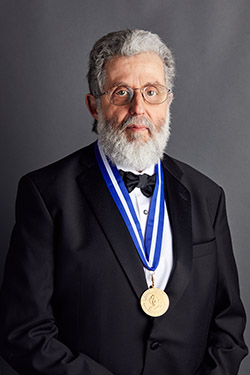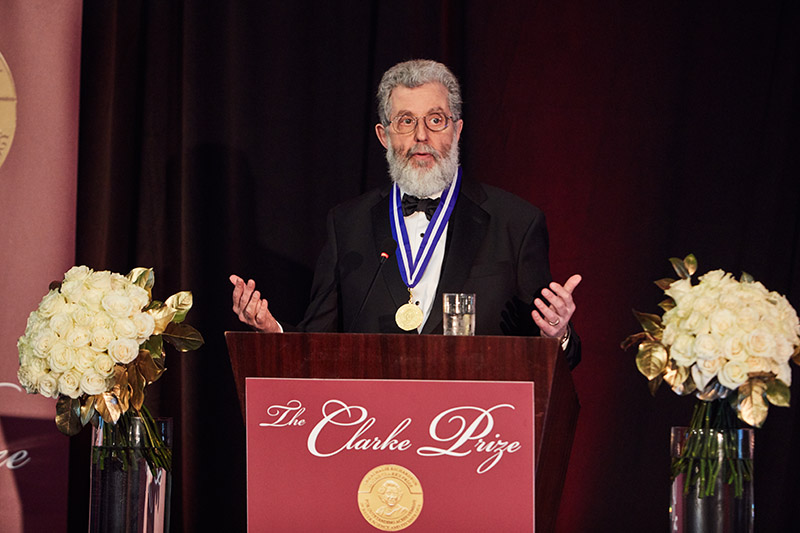
Charles N. Haas
A few months ago, when Chuck Haas walked to a podium in Irvine, California to receive one of the world’s most prestigious water research prizes, he gave a lecture that sounded a bit like the plot for a thriller movie. He described real-world, waterborne villains like Legionella and non-tuberculosis Mycobacterium and the scientists who seek to thwart them in an ongoing, high-stakes, international crusade for water safety. Turns out, that is a pretty apt description.
Charles N. Haas, PhD, the LD Betz Professor of Environmental Engineering and department head for Civil, Architectural and Environmental Engineering (CAEE), is one of the biggest players in that global drama. The National Water Research Institute (NWRI) recently recognized his status with its highest accolade, the 2017 Athalie Richardson Irvine Clarke Prize, for pioneering methods to assess and minimize health risks caused by waterborne pathogens.
Haas’ Quantitative Microbial Risk Assessment (QMRA) approaches, introduced in the early 1980s, are the gold standard for calculating the concentration of disease-causing microorganisms in water. The QMRA methodology allows authorities to set standards that characterize microbial risks accurately, and to frame policy around targeted mitigation goals.
The Clarke Prize is one of just a handful of international water prizes. As a Clarke laureate, Haas received a $50,000 cash award and a medallion marking the achievement. The ceremony was attended by colleagues from around the country with whom Haas has worked for decades.

Charles Haas Accepts the 2017 Athalie Richardson Irvine Clarke Prize
“Professor Haas’ accomplishments are exceptional and impact a broad number of scientific fields,” said NWRI Executive Director Kevin Hardy. “His research has led to a better understanding of what is safe when it comes to our water, how we address emerging pathogens, and how we control risks to human health, thereby upholding NWRI’s mission to ensure that safe, reliable sources of water are available now and for future generations.” The NWRI is based in Fountain Valley, California.
Former CoE Dean Joseph B. Hughes, a distinguished professor with CAEE, said Haas’ achievements cannot be underestimated. “This award is really, really a big deal – you cannot receive a higher honor in his area of work. Chuck’s work has been felt, truly, around the globe in assuring the safety of water to billions of people.
“And I think the legacy of Dr. Haas’ education of Drexel students is widely felt in municipal water sectors, in academia around the United States, and in practicing professionals of the environmental engineering profession,” Hughes added.
During the award lecture in California, Haas described a world beset by pathogens that enter the water supply through a number of pathways. Outbreaks of disease and sickness remain a concern and the types of microorganisms that cause them are increasing, including those that are resistant to antibiotics, infecting new populations, and, in the wrong hands, potential agents of bioterrorism.
Haas recalled a conversation in 1978 with a dean from another institution who told him that environmental engineers would be obsolete within 25 years because the world’s environmental problems would all have been solved by then. The problems are still here. Fortunately, so are the environmental engineers.
An Interdisciplinary Student
An early predictor of Haas’ achievements can be found in his interdisciplinary education. He received an undergraduate degree in biology and graduate degrees in environmental engineering. Fittingly, his Clarke Prize lecture was titled “An Engineer to Microbiologists, and a Microbiologist to Engineers.”
“I think that kind of education was essential. Environmental engineers, almost by virtue of what we do, draw on a lot of disciplines on a need-to-know basis,” Haas said. “So that was really one of the themes of my talk, how we’ve incorporated different streams of knowledge into solving water problems. Early on, we studied things like hydraulics and fluid mechanics, and then it became chemistry and microbiology and public health, and on and on. And it’s still continuing.
“Students should prepare for their careers by exposing themselves to fundamentals in a diversity of fields, because you never know what you’re going to be working on in the future. They need to have breadth to communicate with other professionals.
“I work at the intersection between water, microbiology and health. And so it’s really at those intersections that you get important problems to solve. That’s where you can invent something that hasn’t been looked at before.”
Haas’ Clarke Prize follows a long line of achievements. The insignia after his name reflect a startling range of academic titles: PhD., F. AEESP, BCEEM, F ASCE, F AAAS, F AAM, F IWA, and F SRA. Along with his over 220 publications, professional alliances and consulting activities, advisory memberships, regular appearances in the national news media—coupled with a very active twitter feed—the credentials point to a singular scientist at the pinnacle of a ranging, multidisciplinary 40-year career.
At the very outset of that career, Haas was aware of the limited approaches public health officials used to assess pathogen risk in water supplies. His first groundbreaking publication came in 1983, when he posited that a single ingested microorganism had the potential to cause disease. His argument torpedoed the extant definition of “safe” when treating water supplies for human consumption. He continues to question that threshold today.
“I never use the word safe; I use the word ‘acceptable,’ ” he said. “You can never assure zero risk. You can never assure 100% safe.”
Haas went on to do important work with the United States Environmental Protection Agency as it addressed outbreaks of giardiasis, developing a “dose response” function for the pathogen Giardia. After his seminal work on QMRA was published in 1999, the World Health Organization used it to develop global drinking water standards. Today, Haas is known as the “Father of QMRA.”
On the Horizon
Haas said water safety is one of the most pressing national and global challenges going forward. Globally, several billion people face an inadequate and unhealthful water supply.
In the United States, the deterioration of water delivery systems remains one of the largest threats to water safety. Maintenance and rehabilitation and “reinvention” are ongoing needs. Storm runoff and inadequate cleanup efforts have allowed groundwater contaminants from years and decades past to continue menacing public water supplies. Each year brings another disease-bearing microorganism surging into the limelight.
For example, scientists are waging an accelerating fight against Legionella bacteria, which entered the national lexicon in 1976 with the death of 22 individuals from Legionnaire’s disease at a luxury hotel here in Philadelphia. In fact, Haas was recently appointed to serve on a new National Academy of Sciences, Engineering and Medicine committee on “Management of Legionella in Water Systems.” He also has a multi-year project proposal pending with Virginia Tech to obtain data and set standards to target Legionnaire’s disease.
Haas is optimistic about future water safety developments, he said, because local officials are taking greater leadership roles in addressing local and regional problems.
“We’re re-entering the stage where rather than so much activity being driven by federal requirements, more and more state and local units of government are the driving forces,” said Haas. “We’ve been working continually in this area.
“Here we’re blessed, because the Philadelphia Water Department is one of the best water agencies in the country,” added Haas, who lives in the city. “But we also have right nearby both the American Water Company and Aqua America, the number one and number two investor-owned water utilities. In fact, Aqua has a number of Drexel alumni in its leadership. We have good relationships with both of them.”
The NWRI was founded in 1991 by a group of Southern California water agencies in partnership with the Joan Irvine Smith and Athalie R. Clarke Foundation to promote the protection, maintenance, and restoration of water supplies and to protect the freshwater and marine environments through the development of cooperative research work. The Clarke Prize was established in 1993.